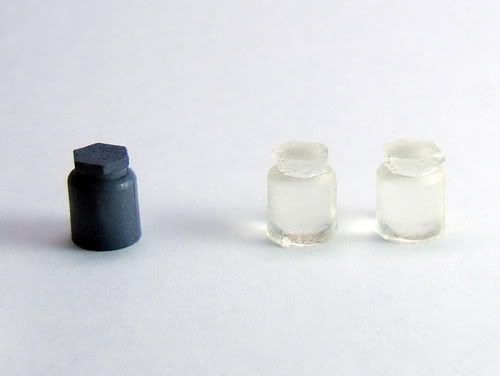The object of my experiments is a miniature Sylvanian Families jam jar. Its default colour is a horrible solid grey (grey strawberry jam and marmalade? Bleah, that's some really off jam.) and painting the jars resulted in failure. I decided that I wanted a translucent look to my jars so casting copies in resin it was.
On the left is the original jar and the the two on the left are test casts I made to see how translucent the resin was. Looked pretty good to me despite the numerous bubbles in them. I just have to not stir so hard.

I made another mold and put the Oyumaru into a small plastic container before pushing the jam jars into it. I wanted a kind of uniform shape, rather like the one in this tutorial (She used silicone though).
I dripped some red acrylic paint in the resin mixture to dye it. The acrylic just would not dissolve properly, no matter how many times I stirred and poked at the individual lumps of paint. They just divided into lots of smaller lumps. I eventually ended up with a reasonably red batch of resin, but with many tiny flecks of paint throughout. The paint also ended up making the jars opaque after they cured.
Trying to remove the cured jars from the mold presented me with its own set of problems. Looks like Oyumaru is no where near as flexible as silicone. After many minutes of futilely trying to bend the thing I had to cut the molds open. Well, no prob, I can just make more molds right? It's not that har--

Oh. The molding material did not fill in the small area between the top of the lid and the bottle properly. Also, the edges of the lip seemed to be prone to catching bubbles which made dents after curing.
I bought a pack of oil paints and while there were still some tiny specks of undissolved paint, there weren't as big or numerous as the acrylic ones. I put too much paint in so it still looked rather opaque in the end. I tried a slightly different method of molding, but that didn't work out so well. The two halves are unequal in size. Detail was captured beautifully though!

These below are my second latest batch. My latest batch looks pretty similar actually, so I'm not going to photograph them. The tops have come out nicely, but I'm having trouble keeping the bottom half even. The trick with the top is to press the material hard with your fingers into the detailed regions. Unfortunately that doesn't work so well with the bottom as pockets of air tend to form or the material bulges out in unwanted places and distort the mold.

I have an idea on what to do next so we'll see how that goes.

oooo!! i'd always wondered if Oyamaru would work with resin, well, thanks to you, now i know! ^ ^ the results don't look half bad, you could probably chop up the 'failed' ones to make jellied fruit for other mini food works? or grate them down to make kakigori type desserts?
ReplyDeletei think you're getting there! Oyamaru does seem like a pretty good option for one-time projects or simple casts, your experiment has gotten me all excited about it again! XD
Oyumaru doesn't stick to resin, it peels off easily. :) It does leave you with scalded fingers if you're not careful though -_-.
ReplyDeleteThanks for the suggestions on what to do with the failed experiments. I was wondering what the heck I was going to do with so many deformed bottles.